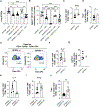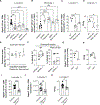Platelets and mast cells promote pathogenic eosinophil recruitment during invasive fungal infection via the 5-HIAA-GPR35 ligand-receptor system
- PMID: 37279752
- PMCID: PMC10360074
- DOI: 10.1016/j.immuni.2023.05.006
Platelets and mast cells promote pathogenic eosinophil recruitment during invasive fungal infection via the 5-HIAA-GPR35 ligand-receptor system
Abstract
Cryptococcus neoformans is the leading cause of fungal meningitis and is characterized by pathogenic eosinophil accumulation in the context of type-2 inflammation. The chemoattractant receptor GPR35 is expressed by granulocytes and promotes their migration to the inflammatory mediator 5-hydroxyindoleacetic acid (5-HIAA), a serotonin metabolite. Given the inflammatory nature of cryptococcal infection, we examined the role of GPR35 in the circuitry underlying cell recruitment to the lung. GPR35 deficiency dampened eosinophil recruitment and fungal growth, whereas overexpression promoted eosinophil homing to airways and fungal replication. Activated platelets and mast cells were the sources of GPR35 ligand activity and pharmacological inhibition of serotonin conversion to 5-HIAA, or genetic deficiency in 5-HIAA production by platelets and mast cells resulted in more efficient clearance of Cryptococcus. Thus, the 5-HIAA-GPR35 axis is an eosinophil chemoattractant receptor system that modulates the clearance of a lethal fungal pathogen, with implications for the use of serotonin metabolism inhibitors in the treatment of fungal infections.
Keywords: 5-HIAA; Cryptococcus; GPR35; cell migration; eosinophils; lung; mast cells; platelets.
Copyright © 2023 The Authors. Published by Elsevier Inc. All rights reserved.
Conflict of interest statement
Declaration of interests The authors declare no competing interests.
Figures






References
Publication types
MeSH terms
Substances
Grants and funding
LinkOut - more resources
Full Text Sources
Molecular Biology Databases

